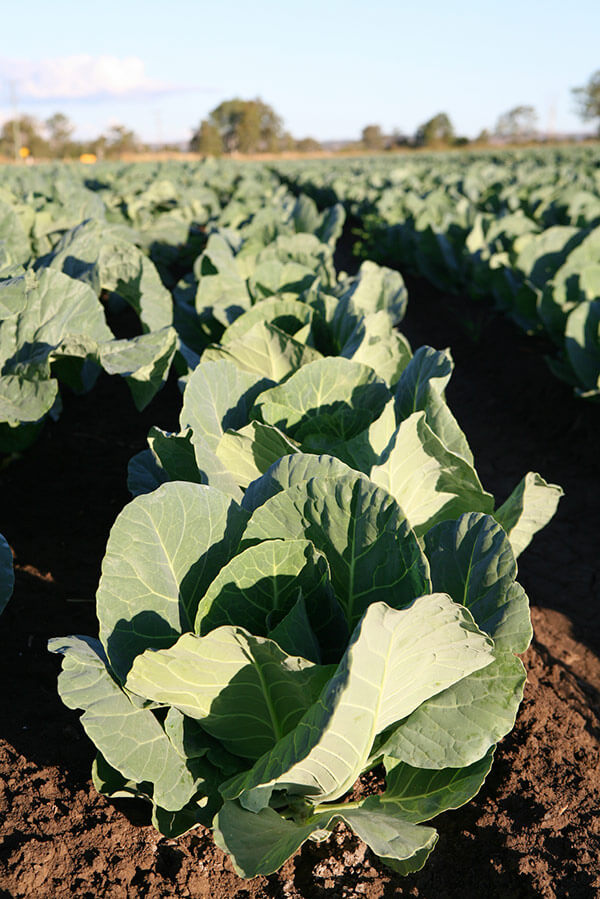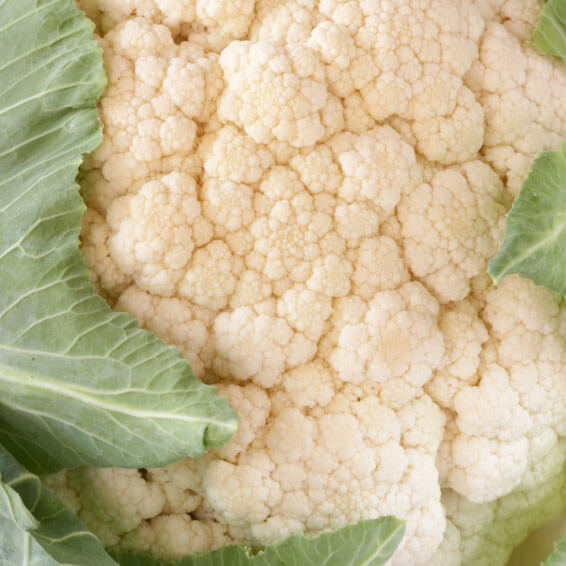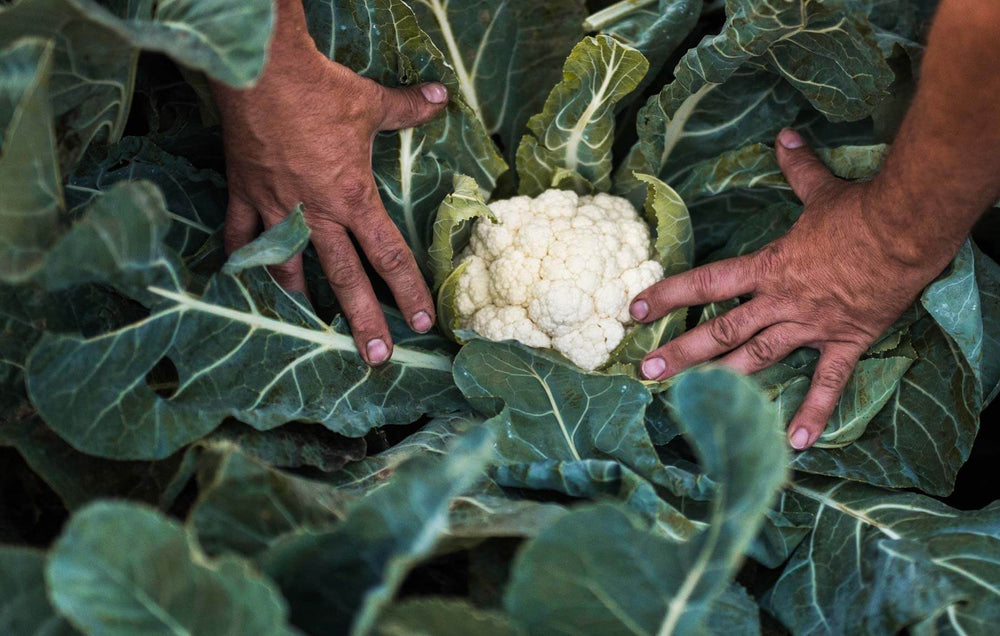Cauliflower is a cool-season crop in the cole family (Brassica oleracea), which includes broccoli, Brussels sprouts, cauliflower, collards, kale, and kohlrabi. However, it is more temperamental than its relatives. The trick to growing cauliflower is consistently cool temperatures, which is why almost three-fourths of commercial cauliflower is grown in the coastal valleys of California. However, you can try growing it at home no matter where you live, but timing is important to catch the temperature just right. It also needs rich soil and a steady supply of water and nutrients. Cauliflower likes temperatures in the 60s. In young cauliflower plants there is a fine balance between leaf and head growth. Any stress tips the balance toward premature heading, or "buttoning," when the plant makes tiny button-sized heads. This can happen when it's too hot or too cold. This also happens if plants sit in packs too long, or are stunted by drought or poor soil. Now that you know the challenges, allow us to equip you for success.
Quick Guide to Growing Cauliflower
- Plant spring cauliflower 2 to 4 weeks before the last frost. Both in-ground gardens and containers are good options.
- Plant cauliflower in rows with each plant spaced 18 inches apart. Rows should be 30 inches apart.
- Improve your native soil by mixing in several inches of compost or other rich organic matter.
- Add a 3-inch layer of mulch and give plants 1 to 1.5 inches of water weekly.
- Cover young plants to protect them from cold weather.
- When the cauliflower head is about the size of a golf ball, gently fold leaves over the head and secure them in place with twine.
- Harvest cauliflower heads when they are still compact but large enough to eat (about 6 to 8 inches in diameter).
Soil, Planting, and Care
If you're looking to get the most you can out of your cauliflower plants in terms of growth and harvest, start with Bonnie Plants® cauliflower plants instead of seeds. Bonnie has over a century of experience providing quality plants for home gardeners, so you can rely on us. Plus, starting with young plants will put you that much closer to harvest time.
Like most vegetables, cauliflower needs at least 6 hours of full sun each day; more is better. It also needs fertile, well-drained, moist soil with plenty of rich organic matter. The soil pH should be between 6.5 and 6.8 for optimum growth and to discourage clubroot disease. To be sure of soil pH, test the soil. You can buy a kit, or get a soil test through your regional Cooperative Extension office. Apply fertilizer and lime according to test recommendations. Add nitrogen-rich amendments such as blood meal, cottonseed meal, or composted manure to the soil, or improve your native soil with aged compost-enriched Miracle-Gro® Performance Organics® All Purpose In-Ground Soil. (Growing in pots? You won't be disappointed if you use Miracle-Gro® Performance Organics® All Purpose Container Mix, which also contains compost but is lighter and fluffier than in-ground soil.) You'll get the best results if, in addition to providing the best soil environment for plant roots, you give your growing cauliflower plants regular feedings of a continuous-release fertilizer like Miracle-Gro® Performance Organics® Edibles Plant Nutrition Granules, which feeds the beneficial microbes in the soil as well as your plants. Fertilize throughout the growing season, following label directions.
Set out spring plants early enough that they can mature before the heat of summer, but not so early that they freeze; 2 to 4 weeks before the last frost is about right. Be prepared to protect them from cold weather with a cover. You can use fabric row covers or homemade items such as old milk jugs.
Set out fall crops about 6 to 8 weeks before the first frost. Be prepared to shade them, if needed, to protect from heat.
Space cauliflower plants about 18 inches apart in the row with 30 inches between rows to allow room for walking. Remember, plants need an even moisture supply to avoid stress. Organic mulch will help keep the soil cool and moist and will suppress weeds. Apply 1 to 1.5 inches of water per week if rain falls short.
When the cauliflower heads are about 2 inches wide, you may need to pull the leaves up over each little head and fasten with a clothespin or twine. This shades the head to ensure it will be white and tender at harvest (called blanching). Plants are supposed to "self-blanch," in which the leaves naturally curl over the head, but watch them because they often need the help of a clothespin.
Troubleshooting
Besides avoiding stresses, watch for cabbage loopers, imported cabbageworms, cabbage root maggots, aphids, and flea beetles. Possible disease pests include black leg, black rot, clubroot, and yellows. Contact your regional Cooperative Extension office for more information on pest identification and current control recommendations. The best way to minimize problems is to keep your plants healthy and your garden clean.
Harvest and Storage
The head is usually ready about a week or so after you tie up the leaves. Leave the head to grow as long as it stays compact (ideally, it will grow to 6 to 8 inches in diameter). You can untie it to peek and tie it back if needed. If the head begins to open up, cut it from the plant at the base of the neck no matter how small it is because it will only decline in quality. The head should keep in the refrigerator for at least 2 weeks.


FAQs
When is the best season to grow cauliflower?
It depends on the area. Cauliflower does not grow well in hot or in severe cold temperatures. Grow in fall, after the temperature is below 75 degrees F, and in winter in locations where the temperature does not fall below 25 degrees.
What does "blanching" mean, and how is it done?
Blanching is the process done to protect the cauliflower head from sunlight. It is done by pulling the outer leaves up over the head of the cauliflower and tying the leaves with a rubber band or soft twine.
Why do my cauliflower plants have small heads?
Cauliflower needs fertile soil that is rich in organic matter in order to hold moisture that will encourage uninterrupted growth; this will prevent heads from forming prematurely.




 Herbs
Herbs
 Vegetables
Vegetables
 Fruit
Fruit
 Flowers
Flowers
 Succulents
Succulents


